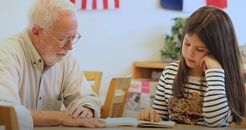 Schools and intergenerational tutoring
Schools and intergenerational tutoring
From an article by The 74
Oasis Intergenerational Tutoring is a programme that which pairs senior volunteers with children in kindergarten thru Year 3 for 30–45 minutes each week. They become their tutor, mentor and friend.
It is overseen by the Oasis Institute, a St. Louis-USA--based non-profit that promotes healthy aging through a mix of community involvement and continuing education. According to the Institute, intergenerational tutoring has spread to 630 schools in 15 states, though its greatest concentration is in Missouri, where it began 35 years ago.
Participating students are identified by their teachers as needing academic or social-emotional support. The average volunteer is around 72 years old. It’s a form of service that also addresses critical needs arising from the educational disruption of Covid-19.
Oasis’s model holds a unique appeal. Its workforce of largely retired volunteers cost school areas a pittance in fees compared to paying for tutors. What’s more, their time in schools yields a secondary benefit to the tutors themselves, who remain engaged in the wider world rather than receding into inactivity. Some spend over a decade in the programme, building friendships with school staff and their fellow tutors. Oasis tutors’ support for students often goes beyond schoolwork. Some stay in touch with their pupils for years afterwards.
Research shows one-on-one and small-group tutoring to be among the most effective educational reforms that schools can use to lift student achievement. A 2020 research review, gathering the results of 96 randomized controlled trials, showcased the wide scope of tutoring offerings that deliver significant learning advantages, including both reading- and math-focused programs that employed either professional educators or community volunteers.
Access to Oasis tutors costs local government and schools a nominal fee, which is estimated to support 6% of the programme’s total price tag. Offerings include reading material and workbooks, summer training for tutors, further coaching during the school year and sometimes help with building program-specific libraries.
Tutors don’t typically bring prior instructional experience to their work (though most are former parents, and many volunteer in a variety of school settings outside of Oasis), but their involvement generally adheres to the guidelines for successful tutoring programs laid out in prior research: It is principally geared toward honing elementary reading skills, conducted at regular intervals and delivered during the school day.
In a sample of 300 students, 97 percent of students working with an Oasis tutor showed improvement in reading performance on a range of standardized exams. In a 2023 survey of educators in schools where Oasis works, 80 percent of classroom teachers said they’d seen improvement in their students’ reading skills, and 67 percent said they’d perceived an improvement in those students’ attitudes at school. Virtually every administrator polled said they would continue to welcome Oasis tutors in their schools.
Whatever the effects of tutoring on young kids, Oasis’s work is also meant to help their volunteers. Gerontologists have long observed the dangerous tendency of seniors to become disconnected from the world outside their homes. The loss of job and social responsibilities, as well as declining physical mobility, has been linked in research studies to higher levels of mortality and severe health problems, including dementia. But when given the chance to be active and help others, seniors’ quality of life can dramatically improve. A 2020 Harvard University study found that adults over 50 who volunteered at least two hours per week were less likely to express loneliness, depression and hopelessness and more likely to be optimistic and purposeful.
Watch this 5 minute video:
Read the full article here.
Retweet about this article:
From an article by The 74, 30/04/2024